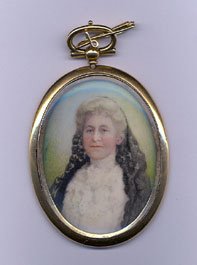Famed Titanic locket sells for $205,000
 In fiction, the "Heart of the Ocean" diamond was the most famous piece of jewelry on board Titanic, but in reality a locket that recently sold at a British auction for $205,000 was among the most famed accessories aboard the ill-fated liner.
In fiction, the "Heart of the Ocean" diamond was the most famous piece of jewelry on board Titanic, but in reality a locket that recently sold at a British auction for $205,000 was among the most famed accessories aboard the ill-fated liner.The locket (pictured at right) was owned by first class passenger Helen Churchill Candee and contained a cherished porcelain painting of her mother. Candee was travelling alone on Titanic and therefore gained a number of male "protectors" including Archibald Gracie, who would later dub their travelling group "our coterie."
On the night of the disaster, Candee had just returned from a concert with the coterie when the ship struck ice. After learning that the captain was ordering women and children to the lifeboats, she dressed warmly, donned her lifejacket and carried the locket with her.
As she ascended the Grand Staircase on the way to the Boat Deck, Candee encountered one of her travel companions, Edward Kent, and entrusted the locket to him as she was about to enter a lifeboat.
The locket was later recovered from Kent's body when it was picked up by the cable ship Mackay Bennett, which was sent to the wreck site to recover bodies of Titanic victims.
The locket is not only famous for its fateful connection to Titanic, but for something even more
impressive. When first class passenger and Titanic survivor Lady Duff Gordon heard the story of the locket, she decided that perhaps women's clothing should have pockets so that in the future women could care for their own jewelry. Duff Gordon was a noted designer of women's fashions under the name "Madame Lucille," and it was in this capacity that Lady Duff Gordon first introduced pockets to women's clothing.
So, ladies, next time you find yourself using your pockets, remember you owe it to the Titanic
sinking, a woman's struggle to save her precious locket and the work of an enterprising Titanic survivor/fashion designer.


0 Comments:
Post a Comment
<< Home